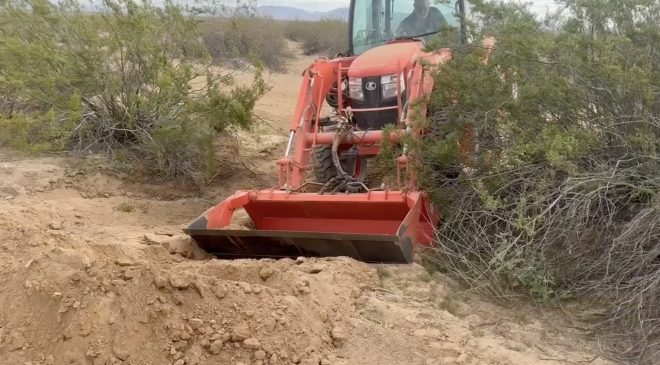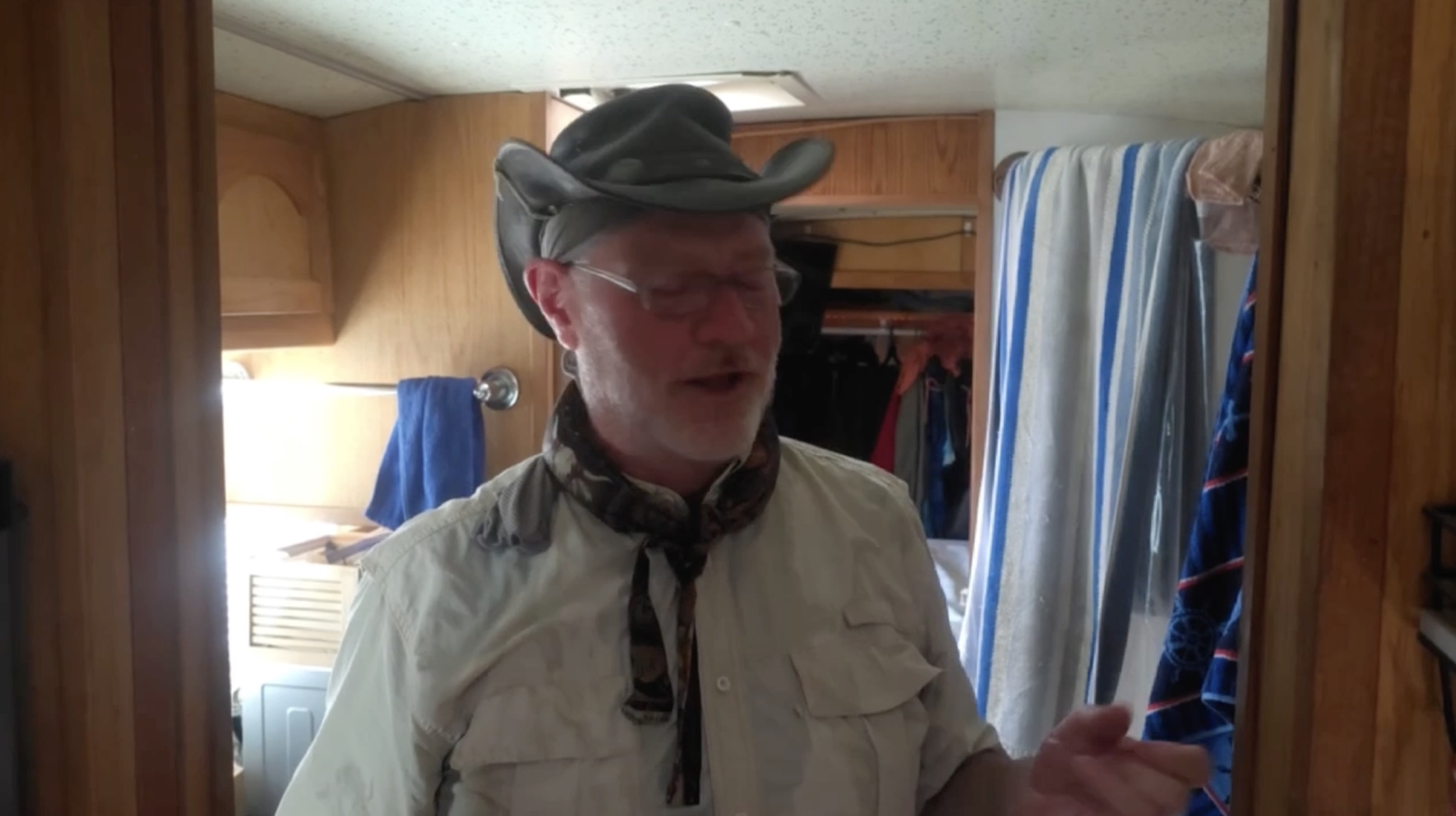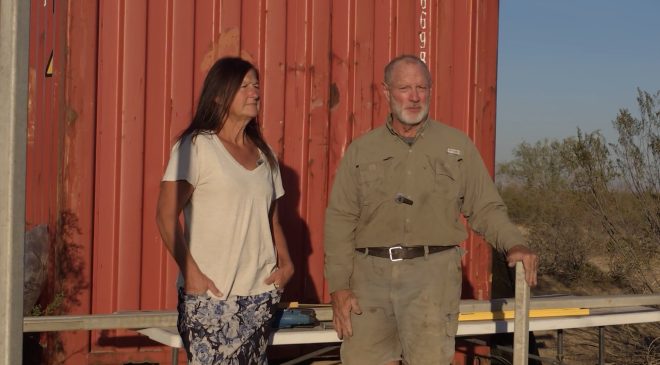
Potato Patch & Container Shuffle: Rainy Day Desert Moves!
In this episode of Occupy the Land, we seize a

In this episode of Occupy the Land, we share our off-grid life in a customized 1980 MCI bus, powered by solar with a 5000 BTU AC keeping us cool in the Arizona desert heat! We showcase our setup, including a studio, refrigerator, and ice machine, all running on 12-13kW of solar storage. We prep for another dome floor pour, tackle flood-proofing with a raised shipping container platform using railroad ties, and plan for monsoon water capture. Join us as we use cooling scarves, dive into our pool, and work on our sustainable desert homestead!
Transcript: Well, a couple of weeks ago, we installed a little window shaker, 5000 BTU just for, like, a 500 square foot. You know, for our bedroom. Well, you know, the bedroom is, you know, we have, you know, escape hatch and, you know, the bed, and we got all the linens off and everything. We will be doing laundry today, and, this is our view.
We wake up every morning and it’s very nice, but we’re able to keep it down in the 60s, if we want to. We probably have it now 75 to 77 degrees, so we don’t get frozen out. And that’s even when it’s, you know, 110 out during the day, in the evening, we get to have, you know, it’s pretty nice and we have a washer and dryer, so that sucked up a lot of the water is doing, you know, washing and so on.
Now. This is our MCI 1980 bus. It’s customized. You know, we have our studio in here and, you know, a lot of, things out there on television. We got, you know, a couch area. You know, it’s it’s pretty nice. Now, this is, you know, a weather station. Yeah. See, it’s, 106. We. Now, what we do is this is not even accurate because we added on another charge controller, so it doesn’t show all the power, but we at least get one kilowatt even in the morning when the sun hits up of charging.
Now we have a max I think goes up to about 400 amp hours, which is, you know, we have like 12, 13kW of storage and that will run be our air conditioner all night so that we can go all night. And about 800W that that draws. And then the next day, boom. Now we got backup generator in case of gets cloudy in the monsoon, there’s no sun and we can just keep the power up.
But generally we we live on solar, you know, and it charges all our tools. All our stuff is battery operated. And, our hand tools and electric and everything. Now, what sucked up a lot of that power is they’re not going to have ice. She’s always running her ice machine. So you know, we got to deal with that.
And we have all the amenities. You know, we got a nice, microwave oven and everything. And refrigerator. Yeah. You know, it’s pretty big refrigerator. You know, it’s a, you know, a refrigerator. So we really don’t suffer. It’s not that bad. We’re able to communicate, you know, we got, you know, a pretty good size, you know, shower and, you know, toilet and everything.
So we’re not suffering too much. But it is hot and we got to get prepped for that. So Donna’s going to you know, show you real quick what I got to do to get ready. These are awesome. They are have water absorbing beads. Kind of like a diaper or something. And, she and I both have one. Then we got this water scarf that we do.
And this is how I get ready for that before we go out. And 50 gazillion degree weather. But this in.
Keeps my head covered. Cool. But this around this makes a big difference. By putting this, I mean it drops the temperature tremendously. And then when we’re, our core gets too hot. You got you got it. Yeah. Take care of your temperature and we’ll jump into the pool. Donna insisted on having a pool out here in the middle of the desert, but, I’m.
I’m glad she did that, because it makes a difference in. Where’s my hat, anyway? I got hat that I put on, you know, this, and then I look cooler, but that back there, I think. We.
Have a couple of different hats. You know my uniform. Well, today we are going to go out and, you know, show you some of the there’s so many different projects that we’re doing. You can see well where’s the house. Oh there’s a whole bunch of other infrastructure going and power and water and storage and workshops and, you know, drainage and roads and everything.
It’s just so much being done. All of a sudden it’s going to be 2 or 3 years being it’s done, you know. But, this week we’re going to be focusing on getting the, cement floor done on the second pad. Oh, really? Third pad that we’re doing now that we’re building a house around. So we’ll go over that.
Some of the other videos showing you, you know, doing that. And then once we get the floor done, we’re going to go ahead. The walls are going to start going up quickly. There’s a lot of design decisions that we’re going to need. Because this dome that we’re doing now is just an experiment. You know, in a lot of different building techniques and materials.
Now we’re going to be focusing on dirty science, dot info, dirty science. It’s the dirt, the soil, the sand. And what you can do is one reason why we picked this particular location, because it had all the material on property. If we’re going to be extremely remote, then you’re having anything delivered. Sand, gravel, topsoil, cement, anything cost more than the material just to have the trucks come out here and deliver.
So the first thing was last summer I finished the roads. So now when we bring in our trailers and we bring in a big 18 Wheeler, trailers and our storage containers that we had to road to support the vehicles even doing it. So this was, you know, important and necessary for us to be able to even get stuff onto the land.
Now we have an hour, you know, when we go to town to get stuff, it’s like a three hour round trip thing that get out there, get stuff and come back. So we try and do that no more than once a week if we can get away with it now, we do have it within 45 minutes to a little general stores and so on, get, you know, milk and a sandwich.
But it’s, and fuel. But what we’re doing is just staying busy. Yeah. Don and I each have our own projects, and we just stay busy, keep on keeping on progress every day. So we’re going to go today and show you some of the little projects that are taking up all our time. And then, but we got to do a sprint, you know, on the, this dome, because for the main foundation and the footers and the, plot and so on for the big home build that we’re doing, we got the area out there for we really wanted to start that by the end of October because you have like a six, seven,
eight month, you know, period to where you just got nice weather all the time. The problem is that the days are a lot shorter. In the summer. We probably get as much or more done even in the heat, because the days are so much longer, you know? Now, of course I could do it for Donna or help Donna, but then she can’t show that she can do it herself.
So. You know, maybe I can.
Move. Then you got to stand it up. So this line here is what connects in to the farm. That we pay $500 a year, and you get as much water as you want. And it takes Donna about. I don’t know, how long does it take you to go get it and come back? It takes me about an hour and 15 minutes round trip about two minutes to fill it up.
Two minutes takes two minutes. I timed it. You have two minutes. Oh, man, that thing goes fast. So it’s a farm. They grow alfalfa or hay, whatever. Nearby. And, Yeah, we found out about them from a neighbor. The guy oh said. Yeah, you know, you pay him, he’ll let you get as much as you want. I’m going.
Cool. So we could do a couple of these at a time if you want. But she just takes one at a time and, you know, there and back. So, you know, probably one day of going back and forth would be enough for a month, you know, that kind of thing. But we need to get larger tanks and we need another source of water for us just eating and drinking.
Not that much. And, you know, bathing. But when you especially, you do a lot of laundry or we’re doing construction, you know, it’s for the cement and so on, wetting the soil. So that’s how we’re doing the water. It’s nicer to have it on property, of course. And we could have done that. But I’m really, really, really, really wanting to green the desert.
And you just cannot pump enough water to meet the monsoon saving it because when it monsoons, it monsoons and it has a lot of water. And if you can retain it in the way the topography is on this land, and how I got the roads and the wash is done, I catch almost all of it. It falls on the property.
So I’m that’s what I’m working on. Getting ready for another pour this morning.
So we’re getting ready for another four. So Ernie is cleaning up the sand there. Some dirt in there, and I kind of. What’s in here? Much? The dirt fly off and, cleans it. So we have more gravel and sand in the mix.
For dirt flies away, and the gravel and sand is left.
We needed to get a shipping container out here for more storage and organized stuff. And this is probably where I wanted it put. Now we have the storage trailer out here. Is like a big Mayflower moving van that we put a lot of stuff when we, left on the Love Bus Liberty tour years ago. And we got it out here, and I created a road to be able to do that.
So, you know, I knew we’d get a shipping container. The problem is, is that this is one of the flood areas. This is the, far north west corner of the property and where I just put, you know, a lot of lay down stuff and supplies and crap and put it back here. Now, the problem was, is because we’re backing up the water that goes, you know, over here, we’re making it to where it saturates the ground with my orders, the holes and so on that I put in.
This is going to be flooded. And what I wanted to do is not have it flood the shipping container. So I went ahead and dug it down, then took the tractor and put a bunch of sand and gravel in here and packed it down. And I had 300 railroad ties delivered that I’m going to be using for fencing around the property.
So that’s why I got a bunch of them. So I took some of those and created a platform here to put the shipping container on and built it up over there and, do the same thing, but I still had to have it to where they could back in here. So we just did. That worked out great.
It’s level left, right, lengthwise. Hope so. We’ll start working on that and I’ll show you what we’re doing with that. For storage. Now, the, tractor, while I was picking up, shipping container, I mean, railroad ties, blue, hydraulics. So I got to take that in. It’s under warranty, and, so. But I got to get it down, so I got to go get some gallons of hydraulics fluid to get it to go on to the trailer, and then I’ll haul it in the next day or two.
Now, this is built up so that it wouldn’t flood that my intention is to flood this. And I didn’t want it going into the shipping container when you had the monsoons. So I had to spend days on this, getting it dug down, getting it compacted using my compactor there, and the railroad ties. And it worked great. They dropped it on the rear back there.
Then we ran over before he dropped it down here, rolled those ties in there. Now I could put an end one here. I’ll worry about that later. So there is, you know, where the bus is. And before that dome over there is where the building site is. It’s kind of a little bit far, but it’s out of the way and I’ll probably be painting this a sand color or a dirt color beige so that, you know, it blends in and did the same thing with this one.
So this is a project this week that I was working on, and I put a bunch of stills in there to give you a better view of it, and I’ll incorporate that in the video. Peace

In this episode of Occupy the Land, we seize a

In this busy-week update from Occupy the Land, Ernie finally
In this episode of Occupy the Land, we explore thriving